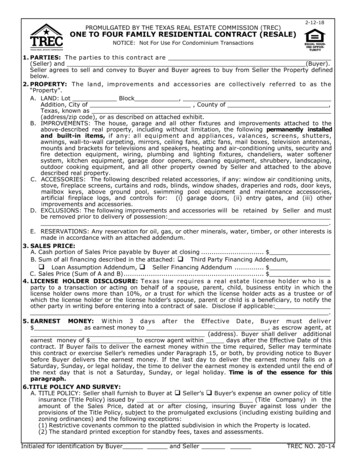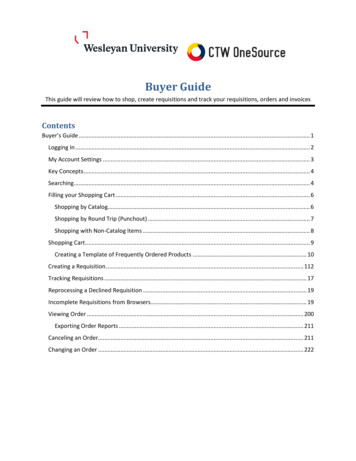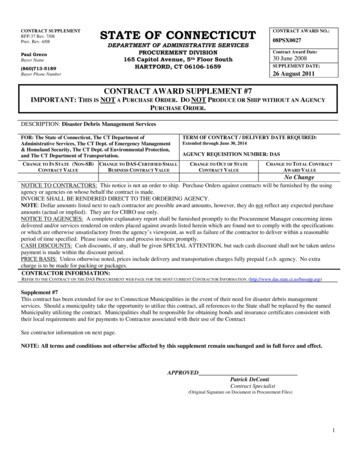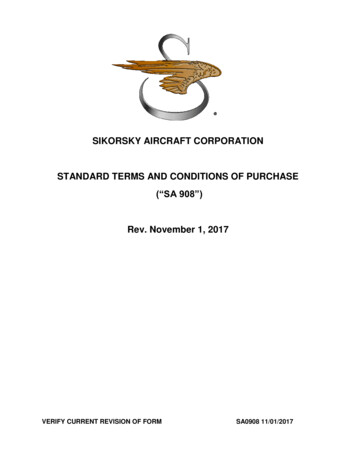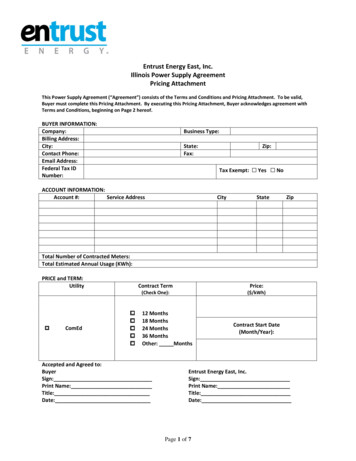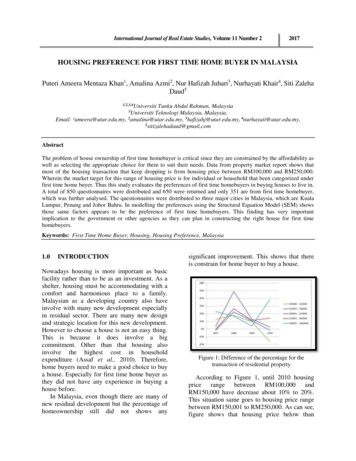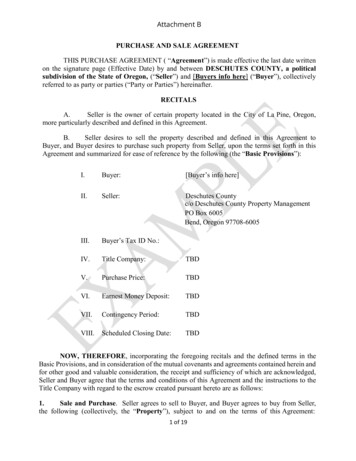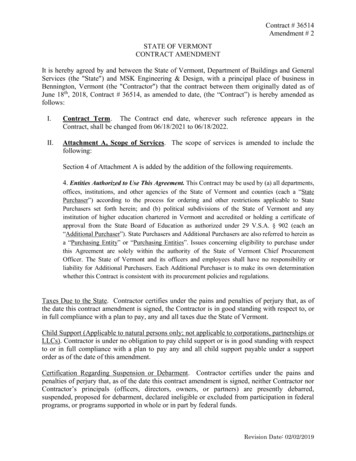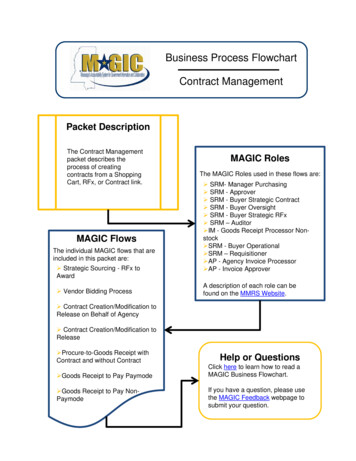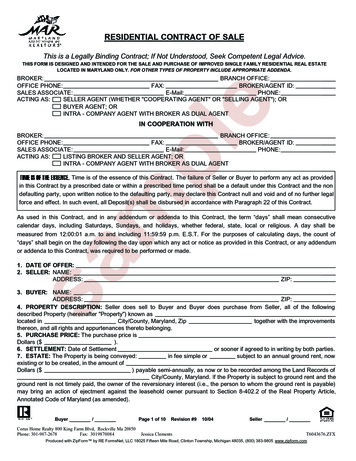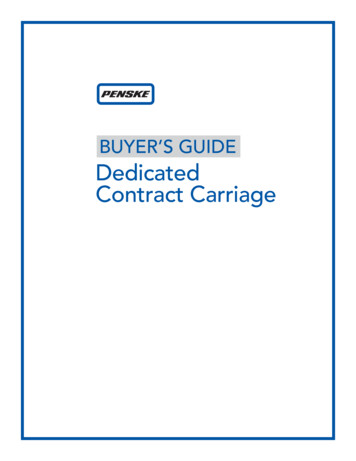
Transcription
BUYER’S GUIDEDedicatedContract Carriage1
When it comes to choosing a Dedicated Contract Carriage (DCC)provider, it’s important to identify your requirements and fullyunderstand the benefits of a well-structured DCC arrangement beforestarting the selection process. That’s why we created this guide – to makeavailable the critical information you need to make the best decisionpossible.Whether you currently operate a private truck fleet, utilize common carriers,or are evaluating the options available in ground transportation, this bookletwill be a helpful resource in determining if DCC is right for you – and itprovides a “how-to” in selecting a specific provider as your dedicatedcarrier.Why is Penske distributing a guide that doesn’t promote its own products?Penske has been providing DCC for over 25 years, and we’re excited aboutthe growth we’re seeing in the industry. One of our observations is thatthere are many first time buyers of the product in today’s environment. Wealso note that there are many new entrants into the market as potentialproviders of dedicated carriage services, and that the product itself hasrapidly evolved in recent years. We’re confident that the more you knowabout DCC, the more likely you are to seriously consider and ultimatelychoose Penske.Penske appreciates this opportunity to assist you in choosing the best DCCprovider for your business.2Dedicated Contract Carriage BUYER’S GUIDE
Table of ContentsDedicated Contract Carriage BUYER’S GUIDEAmount of shipper control4Choices in ground transportation5Baselining private fleet cost6Baselining common carriage cost7Selection process for dedicated companies8Understanding DCC pricing9Dedicated operating models10Preparing for organizational change11Functionality checklist12Moving forward143
4Dedicated Contract Carriage BUYER’S GUIDE
Choices in Ground TransportationPrivate CarriageDo it yourself with your own trucks and drivers. Businesses in service sensitive, competitive industries like the control associatedwith having a private fleet A private fleet operates primarily to transport its own goods Operators of private fleets take responsibility to insure against liability and cargolosses; they generally maintain an infrastructure in terms of safety and complianceto manage this risk“This is my truck, my driver,and I can send them whereI want, when I want toserve my customers.”Dedicated Contract CarriageHave someone else do it, but manage the execution of thedrivers and trucks. Businesses in service sensitive, competitive industries like directing theexecution over equipment and drivers under a dedicated agreement, whilerelinquishing the responsibilities associated with managing a private fleet A dedicated contract carrier is a for-hire carrier dedicated and contracted toexclusively one particular shipper The DCC carrier insures for liability operating under their Department ofTransportation (DOT) authority; responsibility for cargo damage or loss is dictatedby the terms of the dedicated agreement“I control the resources,without having to managethem.”Common CarriageHave someone else do it, often including multiple third-party carriers. Businesses with dynamic volumes, and lower service level sensitivity, find benefit inleveraging less-than-truckload (LTL) and truckload carriers on a transactional basis Common carriers charge on a point-to-point and not a round trip basis; shippers inservice sensitive businesses must balance customer service and cost considerationswhen utilizing common carriers versus the other modes mentioned An alternative to private and dedicated fleets is the use of truckload and LTLcommon carriers; these carriers assume responsibility for liability and cargo losses,and are not dedicated to the shipperDedicated Contract Carriage BUYER’S GUIDE5“My primary concern iscost. I’m less concernedabout control andguaranteed availability.”
Baselining Private Fleet CostTo begin effectively comparing costs, you must conduct anobjective assessment of your existing structure and spend.Assemble an internal team who can identify the direct andindirect costs associated with the operation of your privatefleet.Assessment TeamInvolve any department that provides input to fleet costs,or is subject to output of fleet costs: Finance IT Human Resources Dispatch Risk Customer Service SafetyEquipment Costs Lease payments on equipment (fixed and mileage) Equipment depreciation and cost of capital Fleet maintenance, parts, tires, towing License costs Sales tax on leases Property tax on leased/owned equipment Equipment repairs for damages, accidents Extra rental charges for equipment in accidents Painting or decal expense Onboard computer costInsurance Liability insurance Physical damage/theft insurance Cargo insurance Cost of deductibles on actual occurrences Attorney’s fees in defending legal suitsManagement Costs Cost of administration› Processing driver’s payroll› Advertisements to recruit/hire drivers› Purchasing department costs in buying equipment,insurance, material handling equipment› Payables department time in paying all invoices to privatefleet vendors Cost of supervision› Wages› Payroll taxes› Vacation and holiday pay› Workman’s compensation› Medical benefits (including dependents)› Training costs› Travel costs› Private fleet policy meetings/performance reviews Cost of compliance› Administration of safety policy› Safety meetings/accident review committee› Regulatory compliance (DOT, CSA, FMCSA)› Maintaining driver qualification files› Tax department time with fuel and road taxes› Arbitration cost, union grievance costs, attorney’s fees forlabor issuesMaterial Handling Equipment Pallet jacks Load bars Straps and tarps (flatbed operations) Hand trucksFuel and Road Expenses Actual cost of all fuel used Diesel exhaust fluid Fuel taxes Ton mile and third structure taxes TollsDriver Costs Driver’s cell phone cost Wages and benefits› Wages and payroll taxes› Medical benefits for driver/dependents› Workman’s compensation/disability pay› Vacation and holiday pay› Life insurance› Pension or 401K plan› Bonuses/other incentives Other expenses› Uniforms› Safety and training pay› Drug tests and DOT required medical exams6Dedicated Contract Carriage BUYER’S GUIDE
Baselining Common Carriage CostIt is possible that a portion or all of the freight you currently ship on third-partycarriers can be cost effectively handled with better service levels on a private ordedicated fleet. Below are the three steps to build the basis for a comparison ofcommon carriage versus dedicated.Step 1: Assemble the right data Gather freight bills associated with a normalized period of time in your business;at least two weeks of activity is bestStep 2: Select the right freight for DCC Determine the portion of common carriage activity that would be a target forcomparison; considerations may include:Common CarriageHigh touch freightInside deliveryShort lead timeService is differentiatorNo/low touch freightDock to dock24 - 48 hour lead timeService isn’t differentiatorClosed loop/round tripsHigh density 250 miles 4 stops per routeSpecialized equipmentlift gates, moffits, 48 ft.NetworkAssetsBranded equipmentOne-way moves/no returnsLarge/scattered geography 4 stops per routeStandard equipment1. On-Time DeliveryDCC offers better on-timeperformance, typically measured in 15 minute increments versus 30for common carriage.DCC can deliver directly to stores,bypassing the distribution networkof most common carriers.3. Unattended DeliveryDCC can deliver material at offhours so your locations are stockedand ready upon opening.4. Product Damage48 ft. or 53 ft.DCC drivers know how to handleyour material and reduce damage/loss rates.Non-brandedStep 3: Calculate the cost of common carriage Combine lane rates and accessorial charges to determine an average lanerate; multiply this by the count of trips in each lane Add the cost of managing common carriage› Transportation Sourcing – contracting, procurement, legal, financial andregulatory compliance, safety, carrier management (rates/services)› Execution – order management, load planning, load monitoring, freightbill audit and payment, metrics› Technology – software, hardware Consider other costs› Time spent tracking material› Tracking load status› Dealing with customer service calls› Dealing with carriers› Producing and reviewing metrics› Managing regulatory complianceDedicated Contract Carriage BUYER’S GUIDECommon carriage does notgenerally offer custom serviceoptions, the benefits of which mayoutweigh cost savings in using LTLand truckload carriers.2. Direct Store DeliveryDedicated CarriageServiceService Considerationsfor Shippers75. Brand ConsiderationDCC can place your logo on boththe transportation equipment anddriver uniforms.6. Customer InteractionDCC gives you confidence thatdrivers interacting with customerswill communicate your company’svalues.7. Product MixingDCC ensures that your materialwill not be “mixed” with othercompanies’ products while in transit.
Common Mistakes WhenConverting to DCC1. Providing Bad DataGood data is the foundation to asolid working relationship; providinginaccurate or generalized datacreates complications.2. Assuming Retention RatesBefore assuming key associates willtransition to the dedicated provider,understand the compensation,vacation, benefits and reportingstructure.3. Underestimating Cost ofDriver TurnoverDriver retention enables greatcustomer service. Knowing theroutes, the delivery requirementsand procedures, and the ability tomaneuver at a customer’s locationand dock are all vital for a successfuldedicated operation.4. Failing to Manage ChangeA smooth transition requiresattention to detail. You will needto transfer in-depth knowledge ofyour requirements and expectationsto the dedicated provider in arelatively short amount of time.5. Ignoring ConnectivityAutomating the exchange of data,visibility and actionable reports arefeatures that help drive cost savings.Make sure your plan includes thesefeatures from day one.6. Misjudging Cost Per MileThe most effective way to reducecost is to eliminate miles. A lowercost per mile is not always the most“efficient” cost if it means moremiles.Selection Process for Dedicated CompaniesHaving evaluated your transportation options – and the cost impact of each – youmay have selected to outsource either all or a portion of your existing inbound oroutbound transportation to a dedicated carrier.From the completed analysis you should have a description of what you need. Nowyou must begin to manage the project of selecting an appropriate DCC provider.Before meeting with potential providers, you should be prepared to describe thescope of your requirements in detail, as follows:Step 1 Select a period of normal business activity to modelStep 2 Gather data that clearly identifies your outbound and inbound shipment activityfor the selected period This allows the dedicated providers to model “what if” scenarios Elements of good data – private fleet moves and common carrier shipments› Actual loads shipped by day outbound and inbound (day of month, day of week,time of dispatch)› Tractor and trailer numbers› Driver names› Origin and street level address of destination› Actual time the delivery was received› How long the driver was unloading or loading at the delivery location› Quantity delivered Elements of good data – common carriage moves› Freight bills capturing moves during selected time periodStep 3 Provide the data – preferably electronically – along with any business rules thatshould serve as constraints in modeling a solution, to the dedicated providers These rules might include acceptable delivery windows, critical to quality metrics,material handling requirements, specialized equipment, etc.Step 4 Allow the dedicated providers adequate time to model your dataOn pages 12 and 13 of this document, you will finda functionality checklist to assist with evaluating thecapabilities of potential dedicated transportation providers.8Dedicated Contract Carriage BUYER’S GUIDE
Understanding DCC PricingIt is important to understand the most common dedicated pricing approachesso that you may select the best fit for your business.Fixed and Variable PricingFixed/variable pricing is generally viewed as the best way to align the shipperand dedicated carrier with common goals. The carrier has the fixed andunavoidable cost of the assets and permanent resources covered while theshipper can benefit from leveraging fixed cost against more activity. Fixed weekly charge› Equipment› Technology› Start-up› Management› Benefits for labor› Portion of overhead and margin Variable charge (per mile/stop/hour)› Driver pay› Equipment maintenance cost› Fuel› Insurance› Workman’s comp› Portion of overhead and margin› Payroll taxesQuantifying the Cost:DCC vs. Private FleetStep 1: Multiply your basic operatingstatistics against the quoted variablecharges.Step 2: Add applicable fixed chargesto arrive at a cost per week for themodeled activity.Step 3: Level set each providers’pricing by adding applicable accessorialcharges.Use your baseline private fleet cost todetermine if there is an advantage withDCC.Mileage Rate PricingCarrier charges a flat rate per mile, applied to all activity. This model works wellin a very static environment and provides the shipper predictable costs. Dedicated carriers commonly seek volume minimums from shippers when thispricing model is usedStep 1: Total the freight charges forAccessorial ChargesAccessorial charges will generally apply to any pricing structure. They are usuallyunpredictable events such as fuel costs which fluctuate regularly. Delay and detention› Driver time spent at deliveries and pickups over the agreed upon assumption Fuel surcharge› Fuel cost over the base fuel pricing included in the rates Extra resources› The cost of additional drivers, truck and trailers over the base Lumper fees› Cost of unloading/loading service required by certain customersRemember that regardless of the structure, pricing you receive will reflecta certain number of assumptions made by the provider, and you should beprepared to work with them to understand the cost implications of thoseassumptions.Dedicated Contract Carriage BUYER’S GUIDEQuantifying the Cost:DCC vs. Common Carrier9modeled shipments.Step 2: Apply the dedicated carrier’svariable charges, and any applicablefixed charges, to the operating statisticsgenerated from the modeled data set.Step 3: Level set each providers’pricing by adding applicable accessorialcharges.Compare your common carrier spendwith the dedicated cost to completeyour evaluation.
Questions to HelpUnderstand the Carrier’sOperating Model1. On-Site ManagementHow will the provider managedrivers – remotely or with on-sitemanagers?Dedicated Operating ModelsWithin the DCC space, there are different operating models characterized by thecompanies providing transportation services. On one end of the spectrum you haveservice oriented models, delivering dedicated like a private fleet, and on the otherend you have volume models, delivering truckload-like service.Consider the cost and service implications of driver turnover.Here’s an example of a fleet of 40 drivers, each working 255 days per year.2. Driver TurnoverHow will the provider view driversand the cost to recruit/train them?Are they assets or commodities?3. Asset ImageryWill the provider brand theirassets? Should the driver/truckcommunicate yourbrand/logo/imagery? Will theprovider regularly wash theequipment?4. Equipment ManagementHow does the provider plan tomanage equipment? Will you havevisibility to assets in use?5. MaintenanceHow will the provider maintain theirequipment? What provisions do theymake in the event of a breakdownwhile out making your deliveries? Full Time Equivalent (FTE) turnover: Drivers being replaced within a year Lost workdays: Assumes 90-days lost productivity due to recruiting/training eachreplacement driver Replacement costs: Estimates cost using 9,000/driver industry average6. Replacements and ExtrasHow will the provider procure extraor replacement assets? Will there betrucks and drivers available whenyou need them?Because of the significant cost and service issues that high driver turnovercan generate, select an operating model capable of meeting your servicerequirements and supporting your business with the best long-term value.7. Roadside AssistanceHow will the provider respond in anemergency? When trucks go down,how quickly are they back up?10Dedicated Contract Carriage BUYER’S GUIDE
Preparing forOrganizational ChangeThe decision to outsource does not have to be disruptive toyour organization if you identify and manage the transitionprocess. Senior leaders must demonstrate commitment andidentify clear-cut goals and objectives. Solicit input from alldepartments and personnel impacted by the project.When two organizations come together tosuccessfully manage change, the stage isset for gains beyond what may have beenenvisioned at the outset.Be Honest and Transparent with Employees People fear change Be confident with employees Be prepared that not everyone will be able to transitionHR/Safety Pre-hire process Point of contact for questions/interviews Complete process before “go live” date Training and site inspections Implement programs and communicate to new hiresPrepare an Announcement for Your Employees Name a transition team with well-defined roles andresponsibilities Have a well-groomed project plan› Begin with the end in mind› Track progress› Weekly team meetings to confirm progress Be prepared to answer questions about:› Job security› Time frame for transition› Interview schedules› Vacation time/tenure with new company› Pay structure› Benefits/insuranceTechnology Confirm site location and connectivity Order the necessary equipment (phones, pc’s, etc.) andconfirm delivery of equipment will meet deadline Develop reporting metrics Develop billing system/requirements Confirm order inputs/shipment notificationsReview Implementation After Start-Up Daily progress during the first two weeks Weekly reviews during the first month Quarterly reviews during the first yearSet a realistic “go live” date Depending on the scale of the implementation, operationscan begin within days or weeks Work with the transportation provider to ensure that yourneeds will be met by the start-up timingEquipment Ensure all equipment obligations have been resolved Ensure any new equipment has been requested› Confirm deadline on equipment being in placeDedicated Contract Carriage BUYER’S GUIDE11
Functionality ChecklistGeneral FeaturesExcellentAcceptablePoorCarrier’s financial strength Carrier’s CSA scores Years of experience in DCC Carrier’s operating network compared to your area of operations Preventative maintenance network Road service network Carrier’s operating network compared to your corporate network Management stability Depth of overall logistics capabilities Insurance coverage ExcellentAcceptablePoorExperience within your industry Experience with your delivery requirements References within your industry and delivery requirements Existing fleet equipment condition and appearance Local presence with resources for backup and synergies Plan for staffing supervision for your operation Carrier’s scalability and flexibility Willingness to form true partnership ExcellentAcceptablePoorRecruiting plan Hiring standards Driver compensation plan, including benefits Training procedures Appearance standard Turnover compared to best in class Creative pay for high level service and performance Specific FeaturesDriver Resource Features12Dedicated Contract Carriage BUYER’S GUIDE
Functionality ChecklistValue Add FeaturesExcellentAcceptablePoorSize and experience of logistics engineering department Capability to model “what if” scenarios Engineering tools On-board computer capabilities Logistics technology department Depth of engineering software tools Operation Support FeaturesExcellentAcceptablePoorCustomer synergies for shared equipment and driver resources Regional management accessibility Backhaul department to fill empty miles Safety culture Defined continuous improvement processes Emergency roadside assistance ExcellentAcceptablePoorCustomer portals Real time visibility Standard reporting metrics Custom reporting ExcellentAcceptablePoorDefined plan with timelines Toll gate reviews Project management Experienced team Contingency plan Reporting FeaturesTransition Planning FeaturesDedicated Contract Carriage BUYER’S GUIDE13
Moving ForwardHaving taken a successful first step in outsourcing transportation to adedicated provider, it’s time to think about governance of the relationship.You will establish a rhythm of interaction with the provider, and now youhave the opportunity to take the relationship from successfully achievingtactical benefits to jointly targeting broader strategic goals.14Dedicated Contract Carriage BUYER’S GUIDE
Penske LogisticsPenske Logistics is a wholly owned subsidiary of Penske Truck Leasing. Withoperations in North America, South America, Europe and Asia, PenskeLogistics provides supply chain management and logistics services to majorindustrial and consumer companies throughout the world.Penske Logistics delivers value through design, planning and execution intransportation, warehousing, international freight forwarding and carriermanagement.Dedicated Contract Carriage BUYER’S GUIDE15
Penske Logistics - Global HeadquartersRoute 10 Green HillsReading, PA 19603-0563United States1-888-234-4201gopenske.com 2012 Penske Truck LeasingForm 0000-000 2M (08/12) PC N16
Penske appreciates this opportunity to assist you in choosing the best DCC provider for your business. 3. Dedicated Contract Carriage BUYER'S GUIDE. . › Life insurance › Pension or 401K plan › Bonuses/other incentives Other expenses › Uniforms › Safety and training pay
